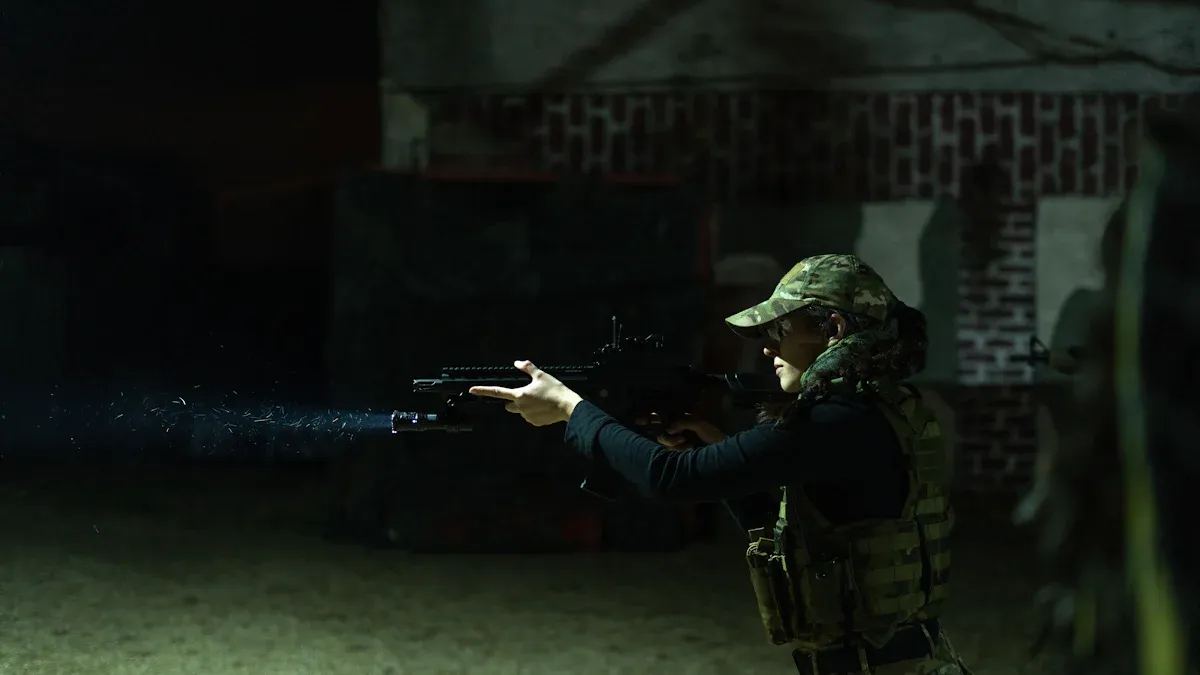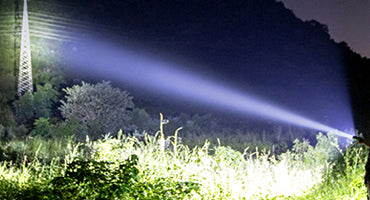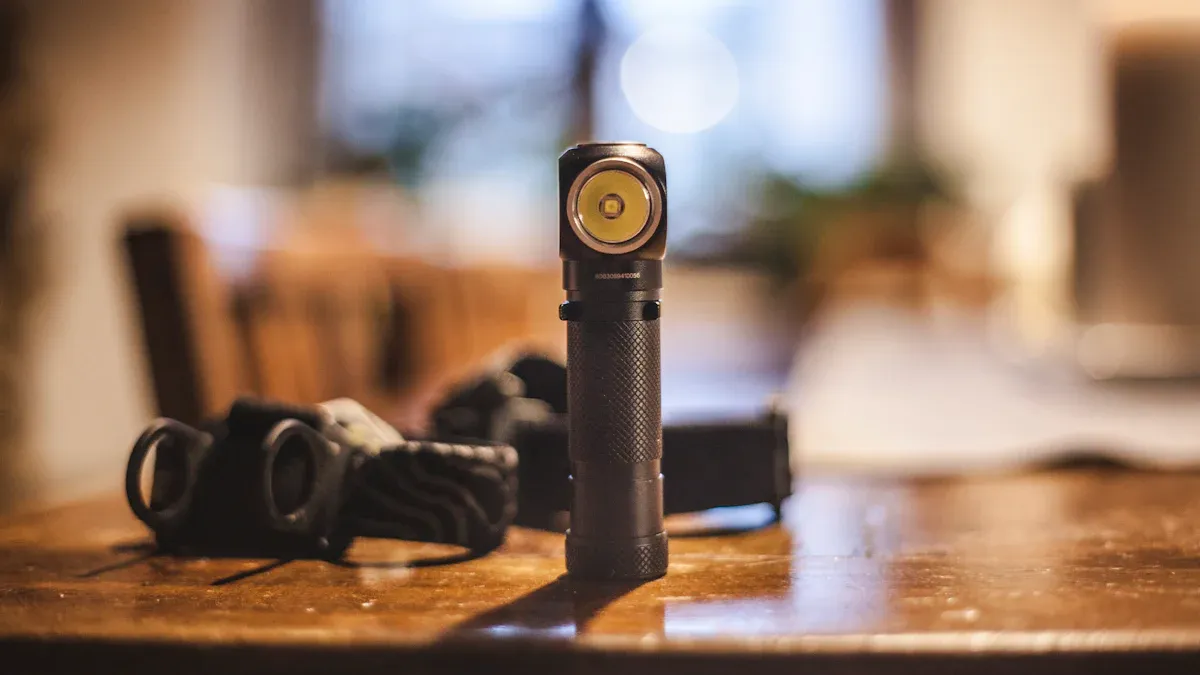Choosing the Right Flashlight for Tactical Medical Use

In high-pressure medical emergencies, you need tools that won’t fail. A reliable flashlight ensures you can assess injuries and provide care, even in low-light conditions. Without a proper Medical Use Flashlight, delays in treatment can occur. Opting for a rechargeable flashlight also reduces downtime, keeping you prepared for critical moments.
Key Takeaways
Pick a flashlight with brightness you can change. This helps in different medical or tactical situations. It makes giving care easier.
Look for a strong and tough flashlight. Aluminum flashlights can handle being dropped or hit during emergencies.
Think about how heavy and easy to carry it is. A lighter flashlight is less tiring and simple to use for a long time.
Unique Needs of Tactical Medical Professionals
Reliability in High-Stress Situations
In high-stress environments, you need a tactical flashlight that performs consistently. Emergencies often involve chaotic conditions, where seconds can mean the difference between life and death. A reliable flashlight ensures you can illuminate critical areas without interruptions. Look for models with robust power systems and dependable switches. These features prevent malfunctions during crucial moments. Additionally, a flashlight designed for tactical applications often includes reinforced construction to withstand drops or impacts. This durability ensures your tool remains functional, even in the most demanding scenarios.
Ease of Use in Emergency Scenarios
During emergencies, simplicity is key. A tactical flashlight should feature intuitive controls that allow you to adjust brightness or switch modes quickly. Complicated designs can slow you down when time is critical. Flashlights with one-handed operation or programmable settings are ideal for medical professionals. They let you focus on patient care without fumbling with your equipment. Furthermore, a flashlight with a textured grip or anti-slip coating ensures you maintain control, even in wet or slippery conditions.
Adaptability to Medical and Tactical Environments
Your flashlight must adapt to both medical and tactical environments. In medical settings, you may need softer light for patient assessments. In tactical situations, brighter beams or strobe modes can enhance visibility or signal for help. A versatile flashlight bridges these needs seamlessly. Models with adjustable brightness levels and multiple modes provide the flexibility required for diverse scenarios. This adaptability ensures you’re prepared for any situation, whether in the field or a controlled environment.
Key Features of a Medical Use Flashlight

Optimal Brightness and Adjustable Modes
A medical use flashlight must offer optimal brightness levels and adjustable modes to suit various tasks. For instance, brightness levels ranging from below 10 lumens to around 80 lumens are ideal. Lower brightness works well for tasks like checking the iris reflex, while higher levels are better for detailed examinations. Adjustable modes allow you to switch between settings like low, medium, high, or strobe, ensuring you have the right illumination for any situation. This versatility enhances your ability to adapt to both medical and tactical scenarios.
Long Battery Life and Power Options
Reliable power is essential for a tactical flashlight. You should consider flashlights with long battery life and versatile power options. Common choices include:
Rechargeable Lithium-Ion Batteries: Offer long runtimes and can be recharged multiple times.
Alkaline Batteries: Widely available but have shorter runtimes.
CR123A Batteries: Provide high energy density and longer shelf life.
Battery Model | Type | Advantages |
|---|---|---|
Nitecore NL1835HP | Lithium-Ion | High energy density, extended lifespan, consistent voltage output |
Olight 18650 | Lithium-Ion | Reliable power, good capacity-to-size ratio |
Xtar 14500 | Lithium-Ion | Higher voltage output than AA, good performance and reliability |
Durable Construction and Impact Resistance
Durability is non-negotiable for a medical use flashlight. Materials like aluminum and stainless steel ensure robust construction. These materials withstand rough handling and challenging conditions, making them ideal for demanding environments. A durable flashlight resists impacts and remains functional even after accidental drops.
Waterproofing and Weatherproof Design
A tactical flashlight must perform reliably in all conditions. Waterproof and weatherproof designs protect against environmental factors like rain, snow, and extreme temperatures. These features ensure your flashlight remains functional in wet or harsh conditions, providing consistent performance when you need it most.
Lightweight and Portable Design
Portability is crucial for medical professionals. A lightweight flashlight reduces fatigue during extended use and allows for easy carrying. Compact designs fit comfortably in your pocket or medical kit, ensuring you always have access to reliable lighting.
Comparing Tactical Flashlight Types for Medical Use

Handheld Flashlights for Versatility
Handheld flashlights offer unmatched flexibility for tactical medical professionals. You can use them for a wide range of tasks, from illuminating a patient’s injuries to signaling for assistance. These flashlights provide tactical advantages without requiring additional tools. For example:
They allow you to focus light precisely where needed, ensuring accurate assessments.
They can serve as non-lethal tools to distract or disorient potential threats.
They help you avoid legal complications that may arise from using more aggressive equipment in non-threatening situations.
Handheld flashlights are compact and easy to carry, making them a reliable choice for diverse scenarios. Their versatility ensures you’re prepared for both medical and tactical challenges.
Headlamps for Hands-Free Operation
Headlamps are essential when you need both hands free for critical tasks. They provide consistent illumination, allowing you to focus entirely on patient care. Adjustable straps ensure a secure fit, even during intense movements. Many headlamps feature multiple brightness settings, enabling you to adapt to different environments. Whether you’re treating a patient in a dimly lit area or navigating through debris, a headlamp ensures you maintain visibility without compromising mobility.
Penlights for Precision Tasks
Penlights excel in situations requiring precision. Their slim design makes them ideal for close-up examinations, such as checking pupil responses or inspecting wounds. These flashlights emit a focused beam, reducing glare and preventing discomfort for patients. Penlights are lightweight and easy to carry in your pocket or medical kit. Their simplicity and reliability make them indispensable for detailed medical assessments.
Multi-Function Flashlights for Emergency Adaptability
Multi-function flashlights combine lighting with additional tools, making them invaluable in emergencies. Many models include high-brightness LEDs for superior illumination and red flashing lights for signaling. Some also feature built-in tools like scissors, screwdrivers, and seatbelt cutters. Safety hammers and compact designs enhance their utility in rescue operations. These flashlights are perfect for tactical medical professionals who need a single device to handle multiple challenges. Their adaptability ensures you’re equipped for any situation, whether it’s a medical emergency or a tactical scenario.
Tips for Choosing the Best Tactical EDC Flashlight
Align Features with Your Medical Role
When choosing the best tactical edc flashlight, consider how its features align with your specific medical responsibilities. If you frequently perform close-up examinations, prioritize models with adjustable brightness and precision beams. For fieldwork, select flashlights with strobe modes or signaling capabilities. A flashlight tailored to your role ensures you can handle diverse scenarios effectively. Always evaluate the flashlight’s versatility to ensure it meets both medical and tactical demands.
Test for Comfort and Ergonomics
Comfort plays a vital role in selecting tactical edc flashlights. You’ll likely use your flashlight for extended periods, so ergonomic design is essential. Look for models with textured surfaces or grip patterns. These features improve handling and reduce slippage, even in wet conditions. Testing the flashlight’s weight and balance is equally important. A well-designed flashlight minimizes hand fatigue and enhances control during critical tasks.
Balance Budget and Quality
Finding the best tactical edc flashlight doesn’t mean overspending. High-quality flashlights are available across various price ranges. Focus on models that offer durability, reliable performance, and essential features within your budget. Avoid compromising on quality for a lower price, as this could lead to frequent replacements. Investing in a dependable flashlight ensures long-term value and consistent performance in emergencies.
Research Trusted Brands and Reviews
Before purchasing a tactical flashlight, research reputable brands known for reliability and innovation. Brands like SureFire, Streamlight, and Fenix have a proven track record in producing high-quality tactical edc flashlights. Read user reviews to gain insights into real-world performance. Reviews often highlight strengths and weaknesses, helping you make an informed decision. Trustworthy brands and positive feedback ensure you select a flashlight that meets your expectations.
A reliable flashlight is essential for tactical medical professionals. Prioritize features like adjustable brightness (100–1,000 lumens), durable materials like aircraft-grade aluminum, and long battery life with rechargeable options. Compact designs with multiple lighting modes enhance adaptability. By focusing on durability, functionality, and portability, you ensure preparedness for any emergency scenario.
FAQ
What is the ideal brightness range for a tactical medical flashlight?
You should look for a flashlight with a brightness range of 10 to 1,000 lumens. This range ensures versatility for both close-up examinations and broader illumination needs.
How do I maintain my flashlight for long-term use?
Clean the lens regularly and check the battery contacts for corrosion. Store it in a dry place and recharge or replace batteries as needed to ensure optimal performance.
Are rechargeable flashlights better than battery-operated ones?
Rechargeable flashlights offer convenience and cost savings over time. However, battery-operated models provide flexibility in emergencies when recharging isn’t possible. Choose based on your specific needs.
💡 Tip: Always carry spare batteries or a portable charger to avoid power issues during critical moments.
See Also
Selecting The Perfect High Intensity Flashlight For Your Needs
Finding The Ideal Headlamp Flashlight For Your Activities
Defining What A Tactical Flashlight Truly Means
